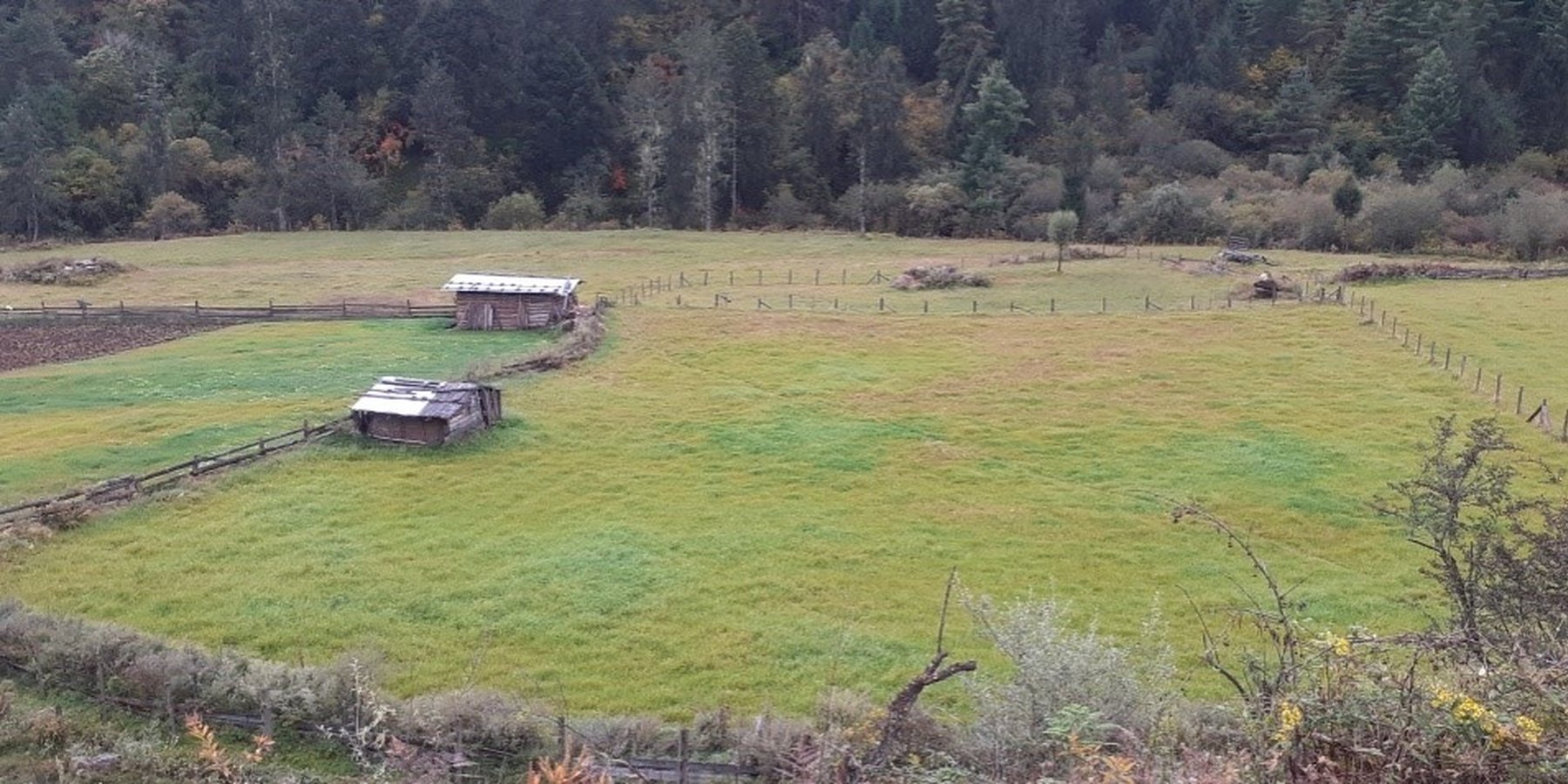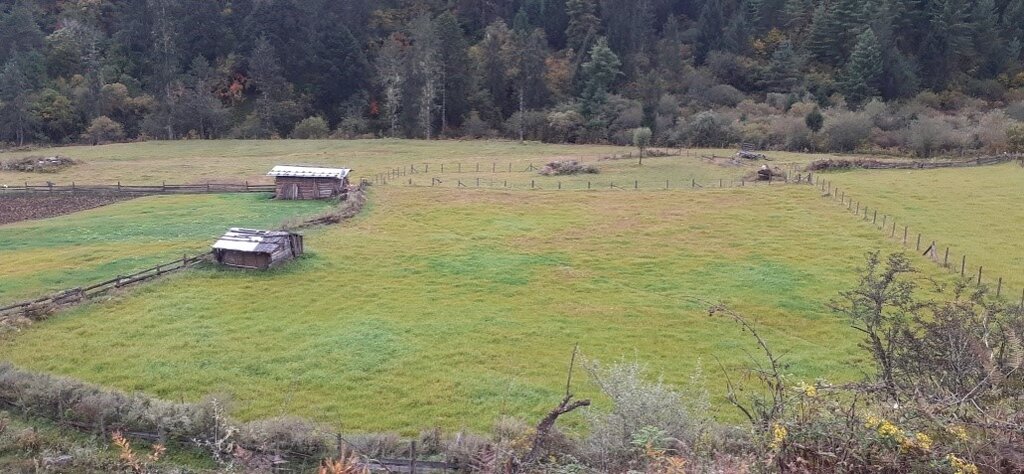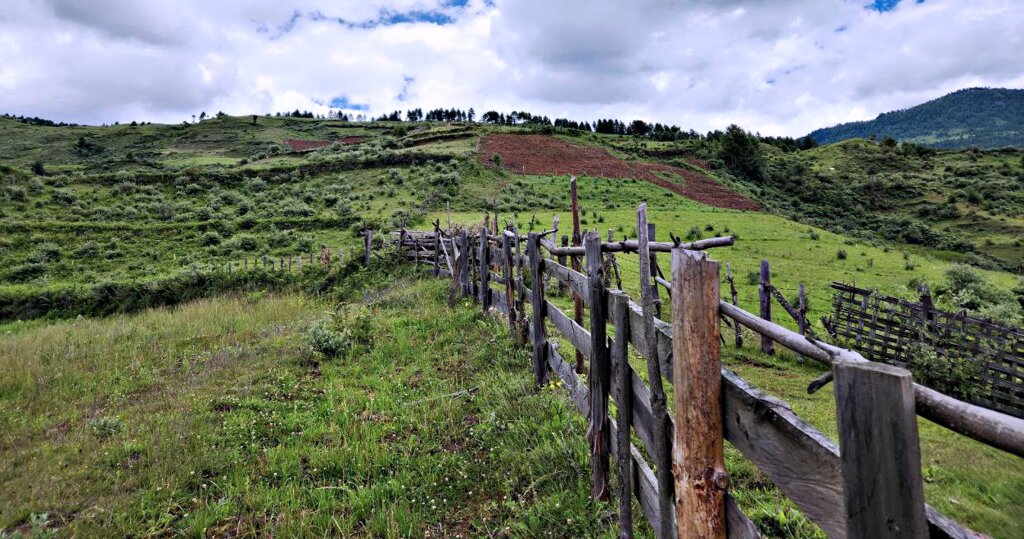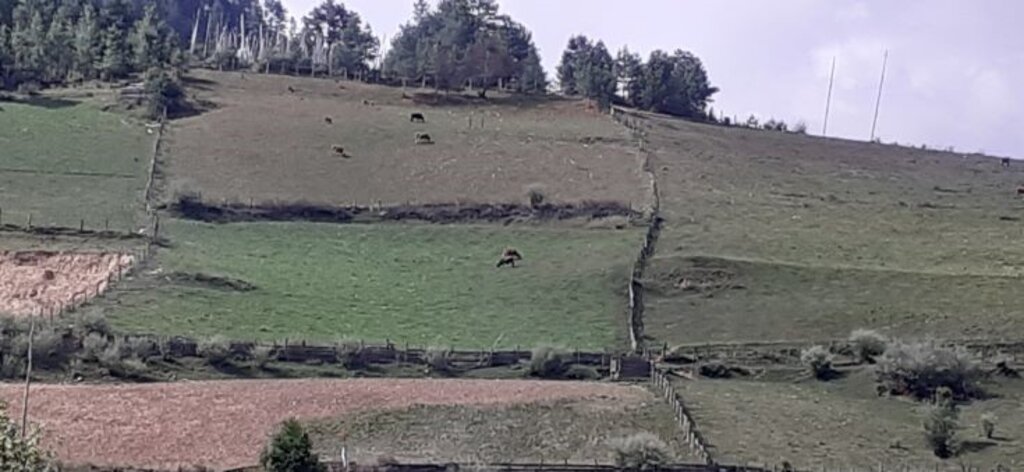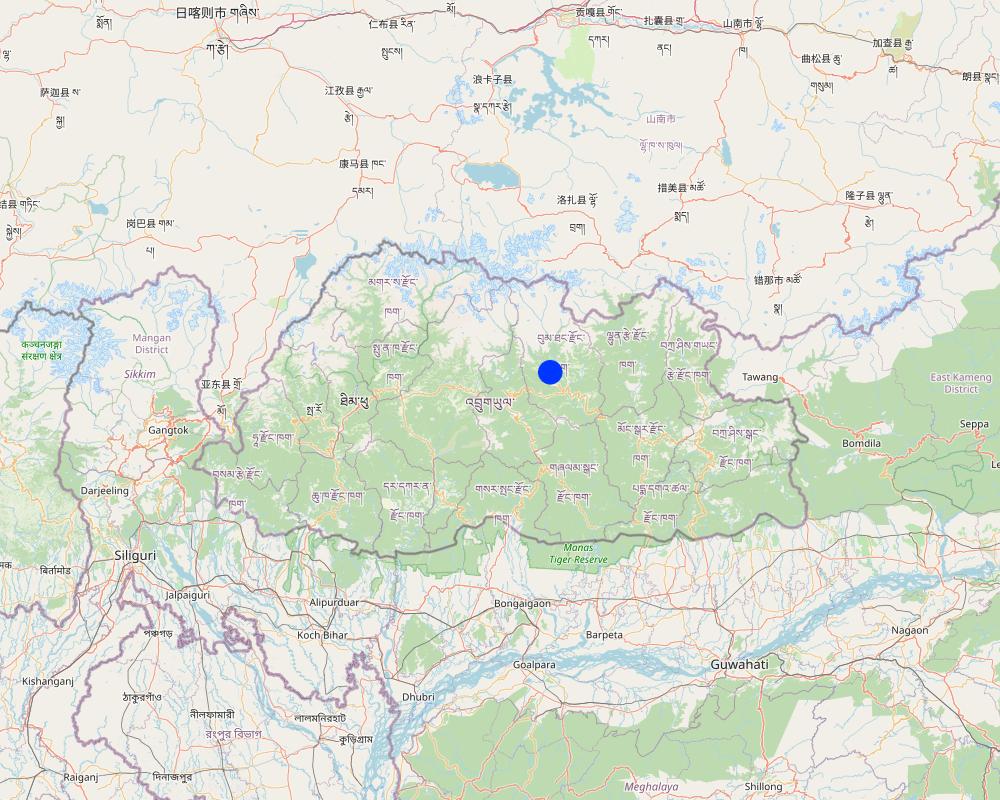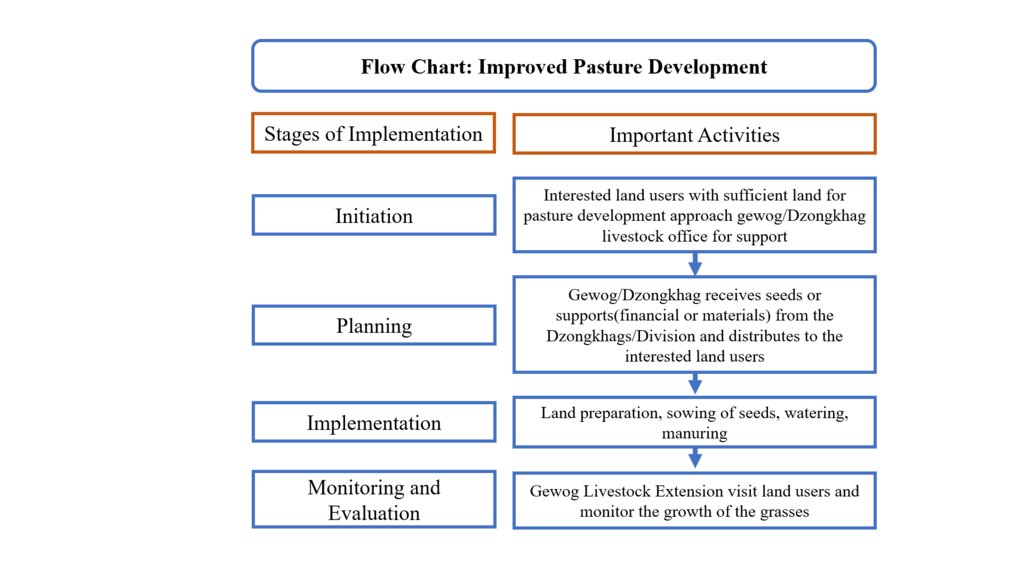Improved Pasture Development [ບູຕານ]
- ການສ້າງ:
- ປັບປູງ:
- ຜູ້ສັງລວມຂໍ້ມູນ: ONGPO LEPCHA
- ບັນນາທິການ: Haka Drukpa
- ຜູ້ທົບທວນຄືນ: William Critchley, Rima Mekdaschi Studer, Joana Eichenberger
Tsamdro Yardrak Tangthang (ཙྭ་འབྲོག་ཡར་དྲག་བཏང་ཐངས་།)
approaches_6858 - ບູຕານ
ເບິ່ງພາກສ່ວນ
ຂະຫຍາຍທັງໝົດ ຍຸບທັງໝົດ1. ຂໍ້ມູນທົ່ວໄປ
1.2 ລາຍລະອຽດ ການຕິດຕໍ່ ຂອງບຸກຄົນທີ່ຊັບພະຍາກອນ ແລະ ສະຖາບັນ ການມີສ່ວນຮ່ວມ ໃນການປະເມີນຜົນ ແລະ ເອກະສານ ຂອງວິທີທາງ
ບຸກຄົນສຳຄັນ (ຫຼາຍຄົນ)
ຜູ້ນໍາໃຊ້ທີ່ດິນ:
Baleymo
Tangbi community
Tangbi, Choekhor Gewog (Block), Bumthang Dzongkhag (District), Bhutan
ບູຕານ
ຜູ້ນໍາໃຊ້ທີ່ດິນ:
Choden Sonam
+97517670437
Tangbi community
Tangbi, Choekhor, Bumthang, Bhutan
ບູຕານ
ຜູ້ນໍາໃຊ້ທີ່ດິນ:
Wangmo Phurpa
+97517951687
Tangbi community
Tangbi, Choekhor Gewog (Block), Bumthang Dzongkhag (District), Bhutan
ບູຕານ
ຊື່ຂອງໂຄງການ ທີ່ອໍານວຍຄວາມສະດວກ ໃນການສ້າງເອກກະສານ ຫຼື ປະເມີນດ້ານແນວທາງ (ຖ້າກ່ຽວຂ້ອງ)
Strengthening national-level institutional and professional capacities of country Parties towards enhanced UNCCD monitoring and reporting – GEF 7 EA Umbrella II (GEF 7 UNCCD Enabling Activities_Umbrella II)ຊື່ຂອງ ສະຖາບັນການຈັດຕັ້ງ ທີ່ອໍານວຍຄວາມສະດວກ ໃນການສ້າງເອກກະສານ ຫຼື ປະເມີນແນວທາງ (ຖ້າກ່ຽວຂ້ອງ)
National Soil Services Centre, Department of Agriculture, Ministry of Agriculture & Livestock (NSSC) - ບູຕານ1.3 ເງື່ອນໄຂ ຂອງການນໍາໃຊ້ເອກກະສານຂໍ້ມູນ ຂອງ WOCAT
ເມື່ອໃດທີ່ໄດ້ສັງລວມຂໍ້ມູນ (ຢູ່ພາກສະໜາມ)?
19/07/2023
ຜູ້ສັງລວມ ແລະ ບັນດາຜູ້ຕອບແບບສອບຖາມ ຍອມຮັບໃນເງື່ອນໄຂ ການນໍາໃຊ້ຂໍ້ມູນເອກະສານ ທີ່ສ້າງຂື້ນ ໂດຍຜ່ານ ອົງການ WOCAT:
ແມ່ນ
2. ພັນລະນາ ແນວທາງການຄຸ້ມຄອງນໍາໃຊ້ດິນແບບຍືນຍົງ
2.1 ການອະທິບາຍ ໂດຍຫຍໍ້ ຂອງວິທີທາງ
The improved pasture development approach focuses on enhancing pasture productivity, which is managed sustainably for grazing. Livestock productivity depends greatly on improved pastures. It is very important to manage pastures to support the livelihoods of rural communities in Bhutan.
2.2 ການອະທິບາຍ ລາຍລະອຽດ ຂອງວິທີທາງ
ການອະທິບາຍ ລາຍລະອຽດ ຂອງວິທີທາງ:
The improved pasture development approach in Bhutan started at the beginning of the 5th Five Year Plan (1982-1987). Thangbi village, Bumthang, focuses on enhancing pastureland productivity and sustainability through the cultivation of improved varieties of grasses provided by the project. This initiative not only prevents land degradation and erosion but also enhances fertility by introducing leguminous species like clover. In temperate areas, improved pasture consists of a mixture of white clover, tall fescue, cocksfoot, and Italian ryegrass while in the subtropical areas, green leaf desmodium, molasses grass (Melinis sp.), ruzi grass (Brachiaria sp.), and stylo are grown.
Given the significant role livestock plays in the livelihood of Bhutanese communities, where productivity is strongly influenced by seasonal variations in fodder availability, improved pasture development addresses crucial objectives. These are: 1) Enhancing the resilience of pasture ecosystems to ensure continuous, high-quality fodder production; 2) Increasing forage availability and quality by promoting the cultivation of improved fodder species; and 3) Improving livestock productivity, directly impacting income generation through increased yields of animal products - especially of milk, cheese, and butter.
Implementation involves four stages: 1) Initial assessments of pasture conditions and land suitability, conducted by livestock extension officials; 2) Planning sessions involving officials from the Department of Livestock and land users; 3) Establishment of the identified areas for growing improved fodder species; and 4) Management of improved pasture plots by land users, accompanied by regular monitoring and evaluation to ensure effectiveness.
Key stakeholders in this approach include livestock extension agents and community members. Livestock extension agents act as a liaison between the community and the government. They also procure and distribute fodder grass seeds. Community members establish pastures in their farms, taking on responsibilities such as monitoring the water supply and caring for the grasses throughout their growing seasons.
Land users appreciate the approach because it ensures abundant fodder availability year-round, improving milk production through the cultivation of superior grass species, and reducing the workload associated with foraging in forests or tending grazing cows. However, concerns raised by land users include a reduction in cultivable land due to fodder grass cultivation and a lack of training regarding fodder management for those involved in the approach.
2.3 ຮູບພາບຂອງແນວທາງ
2.5 ປະເທດ / ເຂດ / ສະຖານທີ່ບ່ອນທີ່ແນວທາງໄດ້ຖືກນໍາໃຊ້
ປະເທດ:
ບູຕານ
ພາກພື້ນ / ລັດ / ແຂວງ:
Bumthang Dzongkhag (District)
ຂໍ້ມູນເພີ່ມເຕີມຂອງສະຖານທີ່:
Thangbi Village, Choekhor Gewog (Block)
Map
×2.6 ວັນທີເລີ່ມຕົ້ນ ແລະ ສິ້ນສຸດ ການຈັດຕັ້ງປະຕີບັດ ວິທີທາງ
ສະແດງປີຂອງການເລີ່ມຕົ້ນ:
1980
ຄວາມຄິດເຫັນ:
The pasture grass seeds are provided to the community members annually free of cost and this approach is continuing until the present.
2.7 ປະເພດຂອງແນວທາງ
- ພາຍໃຕ້ໂຄງການ / ແຜນງານ
2.8 ເປົ້າໝາຍ / ຈຸດປະສົງຫຼັກ ຂອງການຈັດຕັ້ງປະຕິບັດ ວິທີທາງ
1) Enhance the resilience of pasture ecosystems: For countries like Bhutan, fodder production is largely affected by season and during off season, the productivity goes down drastically, leaving many land users in distress. Therefore, improved pasture development enables land users to continuously harvest quality fodder for their cows.
2) Increase forage availability and quality: The improved pasture development approach not only focuses on the production of fodder in quantity but also the quality by encouraging land users to grow improved varieties of fodder species.
3) Improve livestock productivity: Improving productivity is the primary objective as it directly connects to the quantity of animal produce like milk, cheese, butter, etc., that affects the income generated.
2.9 ເງື່ອນໄຂອໍານວຍ ຫຼື ຂັດຂວາງການປະຕິບັດຂອງເຕັກໂນໂລຢີ / ເຕັກໂນໂລຢີການນໍາໃຊ້ຕາມແນວທາງ
ສັງຄົມ / ວັດທະນະທໍາ / ມາດຕະຖານ ແລະ ຄຸນຄ່າທາງສາສະໜາ
- ອໍານວຍ
Community members/land users shared the same social, cultural, and religious norms and values. Implementation of any project didn't have any issues.
ມີຄວາມສາມາດ / ເຂັ້າເຖິງຊັບພະຍາກອນດ້ານການເງິນ ແລະ ການບໍລິການ
- ອໍານວຍ
Community members/land users are provided with improved varieties of fodder grass for free based on the area of the land.
ການກໍ່ຕັ້ງສະຖາບັນ
- ອໍານວຍ
The improved pasture development has helped improve the livelihood of the community members.
ຄວາມຮູ້ກ່ຽວກັບການຄຸ້ມຄອງ ທີ່ດິນແບບຍືນຍົງ, ການເຂົ້າເຖິງການສະໜັບສະໜູນ ທາງດ້ານວິຊາການ
- ເຊື່ອງຊ້ອນ
The land users know that pasture development is directly related to SLM, however land users didn't receive any trainings on the improved pasture development through the approach.
ວຽກ, ມີກໍາລັງຄົນ
- ອໍານວຍ
The workload has relatively decreased: In the past, community members had to go to the forest to either collect fodder or look after cow that graze on the grasses, but now pasture grass is readily available.
3. ການມີສ່ວນຮ່ວມ ແລະ ບົດບາດຂອງພາກສ່ວນທີ່ກ່ຽວຂ້ອງທີ່ໄດ້ມີສ່ວນຮ່ວມ
3.1 ຜູ້ມີສ່ວນຮ່ວມ ໃນວິທີທາງ ແລະ ພາລະບົດບາດ ຂອງເຂົາເຈົ້າ
- ຜູ້ນໍາໃຊ້ດິນໃນທ້ອງຖິ່ນ / ຊຸມຊົນທ້ອງຖິ່ນ
Community members
Receive the fodder grass seeds and establish pasture lands in their registered lands. He/she also monitors the water requirement and takes care of the grasses throughout its growing seasons.
- Department of Livestock, Ministry of Agriculture and Livestock
Livestock extension agent
The livestock extension agent act as a bridge between the community and the governments. He/she handles the project at the grassroots level by meeting and discussing improved pasture development personally with the interested land users. He/she is responsible for procuring the seeds of fodder grasses and distributing them to the community members.
3.2 ການມີສ່ວນຮ່ວມຂອງຜູ້ນໍາໃຊ້ທີ່ດິນໃນທ້ອງຖິ່ນ / ຊຸມຊົນທ້ອງຖິ່ນໃນໄລຍະທີ່ແຕກຕ່າງກັນຂອງແນວທາງ
| ການລວບລວມ ເອົາຜູ້ນໍາໃຊ້ດິນ ໃນທ້ອງຖິ່ນ / ຊຸມຊົນທ້ອງຖິ່ນ | ໃຫ້ລະບຸ ຜູ້ໃດທີ່ມີສ່ວນຮ່ວມ ໃນແຕ່ລະກິດຈະກໍາ? | |
|---|---|---|
| ການເລີ່ມຕົ້ນ / ແຮງຈູງໃຈ | ການບໍ່ປະຕິບັດ | Livestock extension agent upon consultation with research centers will carry out initial assessments of pasture conditions (which species of pasture grass species to be grown) and land suitability study. |
| ການວາງແຜນ | ການຮ່ວມມື | The livestock extension agent and the community members decided on how to establish and implement the project. |
| ການປະຕິບັດ | ການນໍາໃໍຊ້ເອງ | In the initiation phase grass species are already identified and once planning is done. Land users will be provided seeds and they have to establish the pasture on their own. |
| ຕິດຕາມກວດກາ / ການປະເມີນຜົນ | ການນໍາໃໍຊ້ເອງ | Monitoring of pasture field is normally done by the community members, and ocasionally it is monitored by the extension for scheduled reporting purpose. |
3.3 ແຜນວາດ (ຖ້າມີ)
ການອະທິບາຍ:
The flow chart was created based on the information provided by the community members.
ຜູ້ຂຽນ:
Ongpo Lepcha
3.4 ການຕັດສິນໃຈກ່ຽວກັບການຄັດເລືອກເຕັກໂນໂລຢີຂອງການຄຸ້ມຄອງທີ່ດິນແບບຍືນຍົງ / ເຕັກໂນໂລຢີ
ໄດ້ຕັດສິນໃຈເລືອກ ເຕັກໂນໂລຢີ (ຫຼາຍ) ບໍ່?
- Livestock extension agent
ອະທິບາຍ:
The livestock extension agent in consultation with relevant agencies procure and supply pasture grass seeds to interested farmers for pasture development.
- Consultation with research centers
4. ການສະໜັບສະໜູນທາງດ້ານວິຊາການ, ການສ້າງຄວາມສາມາດ, ແລະ ການຈັດການຄວາມຮູ້.
4.1 ການສ້າງຄວາມສາມາດ / ການຝຶກອົບຮົມ
ຜູ້ນໍາໃຊ້ທີ່ດິນ ຫຼື ພາກສ່ວນກ່ຽວຂ້ອງອື່ນໆ ໄດ້ຮັບການຝຶກອົບຮົມບໍ່?
ບໍ່ແມ່ນ
4.2 ການບໍລິການໃຫ້ຄໍາປຶກສາ
ເຮັດຜູ້ໃຊ້ທີ່ດິນມີການເຂົ້າເຖິງການບໍລິການໃຫ້ຄໍາປຶກສາ?
ແມ່ນ
ລະບຸວ່າການສະໜອງ ການບໍລິການ ໃຫ້ຄໍາປຶກສາ:
- ໃນພື້ນທີ່ຂອງຜູ້ນໍາໃຊ້ດິນ
ອະທິບາຍ / ຄວາມຄິດເຫັນ:
Whenever community members require any sort of technical assistance or advisory services, Livestock Extension agent at their capacity provides the support. however, if higher intervention is required EA solicit supports from the dzongkhag, Central programs and the department of livestockand accordingly provide assistance.
4.3 ສະຖາບັນການສ້າງຄວາມເຂັ້ມແຂງ (ການພັດທະນາອົງການຈັດຕັ້ງ)
ສະຖາບັນ ໄດ້ຮັບການສ້າງຕັ້ງຂື້ນ ຫຼື ໄດ້ຮັບການສ້າງຄວາມເຂັ້ມແຂງ ໂດຍການຈັດຕັ້ງປະຕິບັດ ວິທີທາງບໍ່?
- ມີ, ໜ້ອຍໜຶ່ງ
ລະບຸ ທາງສະຖາບັນ ໄດ້ສ້າງຄວາມເຂັ້ມແຂງ ໃນລະດັບໃດ (ຫຼາຍ):
- ທ້ອງຖິ່ນ
ອະທິບາຍ ສະຖາບັນການຈັດຕັ້ງ, ພາລະບົດບາດ ແລະ ໜ້າທີ່ຮັບຜິດຊອບ, ສະມາຊິກ ແລະ ອື່ນໆ.
The livelihood of the community has been relatively better with the improved pasture development.
- Planting materials
ໃຫ້ລາຍລະອຽດເພີ່ມເຕີມ:
The extension agent would provide improved pasture grass seeds based on the availability of budget for seeds procurement.
4.4 ຕິດຕາມກວດກາ ແລະ ປະເມີນຜົນ
ການຈັດຕັ້ງປະຕິບັດ ວິທີທາງ ໄດ້ມີການປະເມີນຜົນ ແລະ ຕິດຕາມບໍ?
ແມ່ນ
ຄວາມຄິດເຫັນ:
Monitoring is mostly done by the community members.
ຖ້າແມ່ນ, ເອກກະສານສະບັບນີ້ ແມ່ນໄດ້ນໍາໃຊ້ເຂົ້າໃນການຕິດຕາມ ແລະ ປະເມີນຜົນບໍ່?
ບໍ່ແມ່ນ
4.5 ການຄົ້ນຄວ້າ
ນີ້້ແມ່ນສ່ວນໜຶ່ງ ການຄົ້ນຄວ້າ ຂອງວິທີທາງບໍ່?
ບໍ່ແມ່ນ
5. ການສະໜັບສະໜູນທາງດ້ານການເງິນ ແລະ ອຸປະກອນຈາກພາຍນອກ
5.1 ງົບປະມານປະຈໍາປີ ສໍາລັບວິທີທາງ ຂອງການຄຸ້ມຄອງ ທີ່ດິນແບບຍືນຍົງ
ຖ້າຫາກບໍ່ຮູ້ຈັດງົບປະມານທີ່ແນ່ນອນ ແມ່ນໃຫ້ປະມານເອົາ:
- 10,000-100,000
ຄໍາເຫັນ (ຕົວຢ່າງ: ແຫຼ່ງຂໍ້ມູນຫຼັກ ຂອງການສະໜອງທຶນ / ຜູ້ໃຫ້ທຶນທີ່ສໍາຄັນ):
The funding is mostly in terms of cost of the improved pasture grass varieties.
5.2 ການສະໜັບສະໜູນ ທາງດ້ານການເງິນ / ອຸປະກອນ ສະໜອງໃຫ້ແກ່ຜູ້ນໍາທີ່ດິນ
ຜູ້ນໍາໃຊ້ດິນ ໄດ້ຮັບການສະໜັບສະໜູນ ທາງດ້ານ ການເງິນ / ອຸປະກອນ ໃນການຈັດຕັ້ງປະຕິບັດ ເຕັກໂນໂລຢີບໍ?
ບໍ່ແມ່ນ
5.3 ເງິນສົມທົບສໍາລັບການນໍາໃຊ້ສະເພາະປັດໃຈຂາເຂົ້າໃນການຜະລີດກະສິກໍາ (ລວມທັງແຮງງານ)
- ບໍ່ມີ
5.4 ສິນເຊື່ອ
ໄດ້ປ່ອຍສິນເຊື່ອ ສະໜອງໃຫ້ພາຍໃຕ້ ວິທີການສໍາລັບກິດຈະກໍາ ການຄຸ້ມຄອງ ທີ່ດິນແບບຍືນນຍົງບໍ່?
ບໍ່ແມ່ນ
5.5 ສິ່ງຈູງໃຈ ຫຼື ເຄື່ອງມືອື່ນໆ
ການສົ່ງເສີມ ຈັດຕັ້ງປະຕິບັດ ເຕັກໂນໂລຢີ ໃນການຄຸ້ມຄອງ ດິນແບບຍືນຍົງ ໄດ້ສະໜອງສິ່ງກະຕຸກຊຸກຍູ້ບໍ່?
ບໍ່ແມ່ນ
6. ວິເຄາະຜົນກະທົບ ແລະ ສັງລວມບັນຫາ
6.1 ຜົນກະທົບຂອງແນວທາງ
ການຈັດຕັ້ງປະຕິບັດ ວິທີທາງ ສາມາດຊ່ວຍຜູ້ນໍາໃຊ້ທີ່ດິນ ໃນການຈັດຕັ້ງປະຕິບັດ ແລະ ບໍາລຸງຮັກສາ ເຕັກໂນໂລຢີ ການຄຸ້ມຄອງ ທີ່ດິນແບບຍືນຍົງໄດ້ບໍ?
- ບໍ່
- ມີ, ໜ້ອຍໜຶ່ງ
- ມີ, ພໍສົມຄວນ
- ມີ, ຫຼາຍ
No workshop or tainings were provided to the community members, however, they relied on their traditional knowledge on pasture land management.
ການນໍາໃຊ້ ວິທີທາງ ສາມາດປັບປຸງຄວາມຮູ້ ແລະ ຄວາມສາມາດຂອງຜູ້ນໍາໃຊ້ທີ່ດິນ ໃນການປະຕິບັດ ການຄຸ້ມຄອງ ທີ່ດິນແບບຍືດຍົງໄດ້ບໍ່?
- ບໍ່
- ມີ, ໜ້ອຍໜຶ່ງ
- ມີ, ພໍສົມຄວນ
- ມີ, ຫຼາຍ
Community members relied on their traditional knowledge about pasture grass management
ການນໍາໃຊ້ ວິທີທາງ ສາມາດສ້າງຄວາມເຂັ້ມແຂງ ໃຫ້ສະຖາບັນການຈັດຕັ້ງ, ການຮ່ວມມື ລະຫວ່າງພາກສ່ວນທີ່ກ່ຽວຂ້ອງບໍ່?
- ບໍ່
- ມີ, ໜ້ອຍໜຶ່ງ
- ມີ, ພໍສົມຄວນ
- ມີ, ຫຼາຍ
The livelihood of the community has relatively improved compared to the past.
ການຈັດຕັ້ງປະຕິບັດ ວິທີທາງ ສາມາດສ້າງຄວາມເຂັ້ມແຂງ ທາງສັງຄົມ ແລະ ເສດຖະກິດບໍ່?
- ບໍ່
- ມີ, ໜ້ອຍໜຶ່ງ
- ມີ, ພໍສົມຄວນ
- ມີ, ຫຼາຍ
All the households in the community irrespective of their background were provided with the pasture grass seeds.
ການຈັດຕັ້ງປະຕິບັດ ວິທີທາງ ສາມາດປັບປຸງ ຄວາມສະເໜີພາບ ຂອງບົດບາດ ຍິງຊາຍ ແລະ ສ້າງຄວາມເຂັ້ມແຂງໃຫ້ຜູ້ຍິງໄດ້ບໍ່?
- ບໍ່
- ມີ, ໜ້ອຍໜຶ່ງ
- ມີ, ພໍສົມຄວນ
- ມີ, ຫຼາຍ
All genders were equally encouraged to participate
ການນໍາໃຊ້ ວິທີທາງ ໄດ້ປັບປຸງ ການຄໍ້າປະກັນສະບຽງອາຫານ ຫຼື ປັບປຸງໂຄສະນາການໄດ້ບໍ່?
- ບໍ່
- ມີ, ໜ້ອຍໜຶ່ງ
- ມີ, ພໍສົມຄວນ
- ມີ, ຫຼາຍ
The cultivated land has decreased due to the improved pasture land
6.2 ແຮງຈູງໃຈຫຼັກຂອງຜູ້ນໍາໃຊ້ທີ່ດິນໃນການປະຕິບັດການຄຸ້ມຄອງທີ່ດິນແບບຍືນຍົງ
- ການຜະລິດເພີ່ມຂຶ້ນ
The introduction of improved pasture grass, has helped improve dairy production in the community
- ຫຼຸດຜ່ອນຄວາມສ່ຽງຂອງໄພພິບັດ
Forest grazing is reduced, resulting to less incidence of human wildlife conflict (livestock depredation)
- ການຫຼຸດຜ່ອນພາລະວຽກ
Since pasture grass is cultivated nearby the workload has decreased
6.3 ຄວາມຍືນຍົງຂອງກິດຈະກໍາວິທີທາງ
ຜູ້ນໍາໃຊ້ ທີ່ດິນ ສາມາດສືບຕໍ່ ການຈັດຕັ້ງປະຕິບັດ ຜ່ານວິທີທາງໄດ້ບໍ່ (ໂດຍປາດສະຈາກ ການຊ່ວຍເຫຼືອ ຈາກພາກສ່ວນພາຍນອກ)?
- ບໍ່ແນ່ນອນ
ຖ້າ ບໍ່ ຫຼື ບໍ່ແນ່ໃຈ, ໃຫ້ອະທິບາຍ ແລະ ຄໍາເຫັນ:
The community member were unsure about its sustainability due to several factors such as rural urban migration and so on.
6.4 ຈຸດແຂງ / ຂໍ້ດີ ຂອງວິທີທາງ
| ຈຸດແຂງ / ຂໍ້ດີ / ໂອກາດໃນການນໍາໃຊ້ທີ່ດິນ |
|---|
| Reduced workload |
| Fodder available in large amount |
| Higher milk production |
| ຈຸດແຂງ / ຈຸດດີ / ໂອກາດ ຈາກທັດສະນະຂອງຜູ້ປ້ອນຂໍ້ມູນ ຫຼື ບຸກຄົນສຳຄັນ |
|---|
| Reduction of surface runoff |
| Increase fertility of the soil |
6.5 ຈຸດອ່ອນ / ຂໍ້ເສຍຂອງແນວທາງ ແລະ ວິທີການແກ້ໄຂໃຫ້ເຂົາເຈົ້າ
| ຈຸດອ່ອນ / ຂໍ້ເສຍ / ຄວາມສ່ຽງໃນມູມມອງຂອງຜູ້ນໍາໃຊ້ທີ່ດິນ | ມີວິທີການແກ້ໄຂຄືແນວໃດ? |
|---|---|
| Reduction in cultivated land | |
| Land users have to depend on livestock officers for seeds | Training on seed production can be given to enhance their skills |
7. ເອກກະສານອ້າງອີງ ແລະ ຂໍ້ມູນການເຊື່ອມໂຍງ
7.1 ວິທີການ / ແຫຼ່ງຂໍ້ມູນ
- ການໄປຢ້ຽມຢາມພາກສະໜາມ, ການສໍາຫຼວດພາກສະໜາມ
One household
- ການສໍາພາດ ຜູ້ນໍາໃຊ້ທີ່ດິນ
Three individuals
7.2 ເອກະສານທົ່ວໄປທີ່ສາມາດໃຊ້ໄດ້
ຫົວຂໍ້, ຜູ້ຂຽນ, ປີ, ISBN:
Marzban, S. & Valizadeh, N. (2020). Pasture Development: Fundamentals and Managerial Perspectives.
ມີຢູ່ໃສ?ມູນຄ່າເທົ່າໃດ?
https://www.researchgate.net/publication/339074876_Pasture_Development_Fundamentals_and_Managerial_Perspectives
7.3 ການເຊື່ອມຕໍ່ກັບຂໍ້ມູນທີ່ກ່ຽວຂ້ອງທີ່ສາມາດໃຊ້ອອນໄລນ໌
ຫົວຂໍ້ / ພັນລະນາ:
Improving the quality of pastures
URL:
https://business.qld.gov.au/industries/farms-fishing-forestry/agriculture/sustainable/graze/pasture/improve
ຫົວຂໍ້ / ພັນລະນາ:
Pasture Development on Small Farms
URL:
https://farmstyle.com.au/news/pasture-development-small-farms
ຫົວຂໍ້ / ພັນລະນາ:
Strategies for improving run down pastures
URL:
https://www.incitecpivotfertilisers.com.au/news-and-insights/agronomic-insights/pasture/strategies-for-improving-run-down-pastures
ຫົວຂໍ້ / ພັນລະນາ:
Pasture Management: Effective Planning & Implementation
URL:
https://eos.com/blog/pasture-management/
ຂໍ້ມູນການເຊື່ອມຕໍ່ ແລະ ເນື້ອໃນ
ຂະຫຍາຍທັງໝົດ ຍຸບທັງໝົດການເຊື່ອມຕໍ່
ບໍ່ມີຂໍ້ມູນການເຊື່ອມຕໍ່
ເນື້ອໃນ
ບໍ່ມີເນື້ອໃນ


